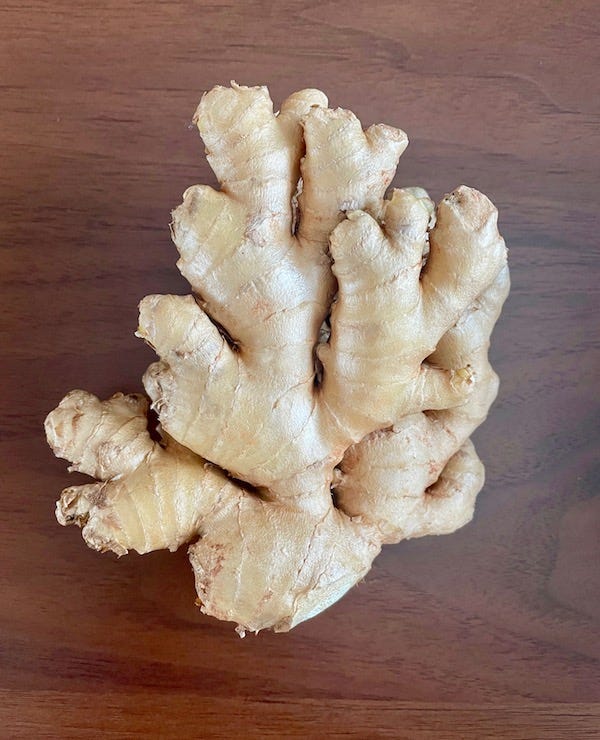Make Fermented Ginger
More musing on going outside, some ginger fun facts, recipe for Fermented Ginger Paste, recipe for starting and maintaining a ginger bug, and one final rabbit hole
After I sent out Tuesday’s letter to you, I went about the household tasks that I needed to catch up on. At the top of the list was laundry. Our dryer broke down years ago; it was a model from the early 1980s and was beyond repair. I love hanging laundry on the line, so I didn’t see the need to replace it. There are very few days in the year when we can’t hang laundry out. On those days, the drying rack near our woodstove takes over. It’s not a convenience I miss. I honestly do enjoy hanging out laundry. All aspects of it are peaceful. When our children were young, it was a quiet moment for me, the mama, to breathe. I like spending the time to hang things out. One of my quirky pleasures is choosing the next shirt or towel to pin the line by color to create patterns that nobody will notice, nor will I honestly, once I’ve left. (My favorite clothes pins.) Taking clothes down requires me to stand outside, where it is lovely, and fold them as they go into the basket as opposed to scooping them out of a dryer in a wad. At least this way, when I don’t put them away in a timely fashion (almost always), they are folded.
And can we talk about smell? I just want to bury my nose in the amazing smells. In the winter, our clothes and linens come in, smelling cool and fresh. In the summer--baked and crispy clean. Here is the thing, this practice forces me to go outside. It was in being out there with the laundry that day that I wondered if this is another way we are bringing a few microbes inside. We know the sun cleanses clothes, but I wonder who does the wind bring along. And those fresh outdoorsy smells – are those the elements or the microbes? Who knows, and likely this isn’t a question that science has thought important enough to ponder. I am pretty certain, though, these clothes aren’t assaulting my microbiome with chemical fresheners and scents; maybe there are more ways we can enliven our microbiome than we realize.
Okay, on to ginger, as promised.
Ginger (Zingiber officinale) is a perennial favorite addition to many fermented goodies. Ginger’s warm, woodsy flavor is pleasingly hot with rich, sweet notes. It is a common ingredient in many traditional fermentations. Ginger possesses anti-inflammatory, analgesic, and cardiac properties for us and is also beneficial to the probiotic microbes. This is particularly interesting because ginger is also antimicrobial. When ginger is added to ferments, it leads to a larger production of LAB at the end of the fermentation and throughout storage. It seems that the antibacterial properties of the gingerols in ginger protect the good bacteria from the bad. (Anecdotally, I see this in my ginger bugs, which I can ignore for months, and yet they rarely degrade to mold or bacteria, despite an unrefrigerated aerobic environment.)
Cultivated in tropical Asia for over 3,000 years, ginger is perhaps one of the oldest fundamental spices and medicines. Its origin is ambiguous, but it was used extensively in the cuisines and medicine of ancient China and India. (Pots found in New Delhi had residues of turmeric, ginger, and garlic from around 2500 BC.) As medicine, ginger has been used to treat stomach upset, diarrhea, and nausea. It stimulates our peptic juices—bile, saliva, pancreatic and intestinal juices.
Keep reading with a 7-day free trial
Subscribe to Fermenting Change to keep reading this post and get 7 days of free access to the full post archives.



